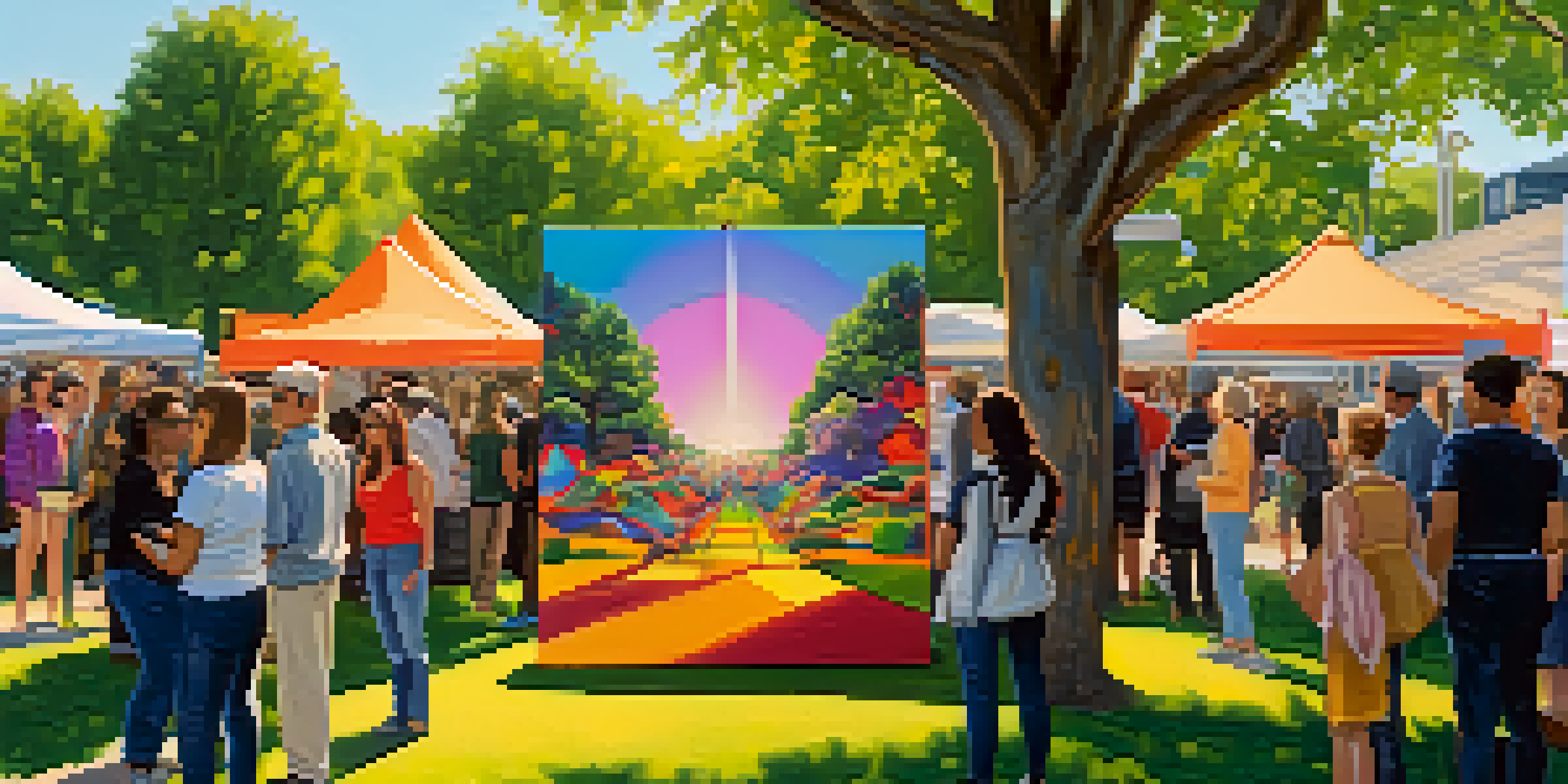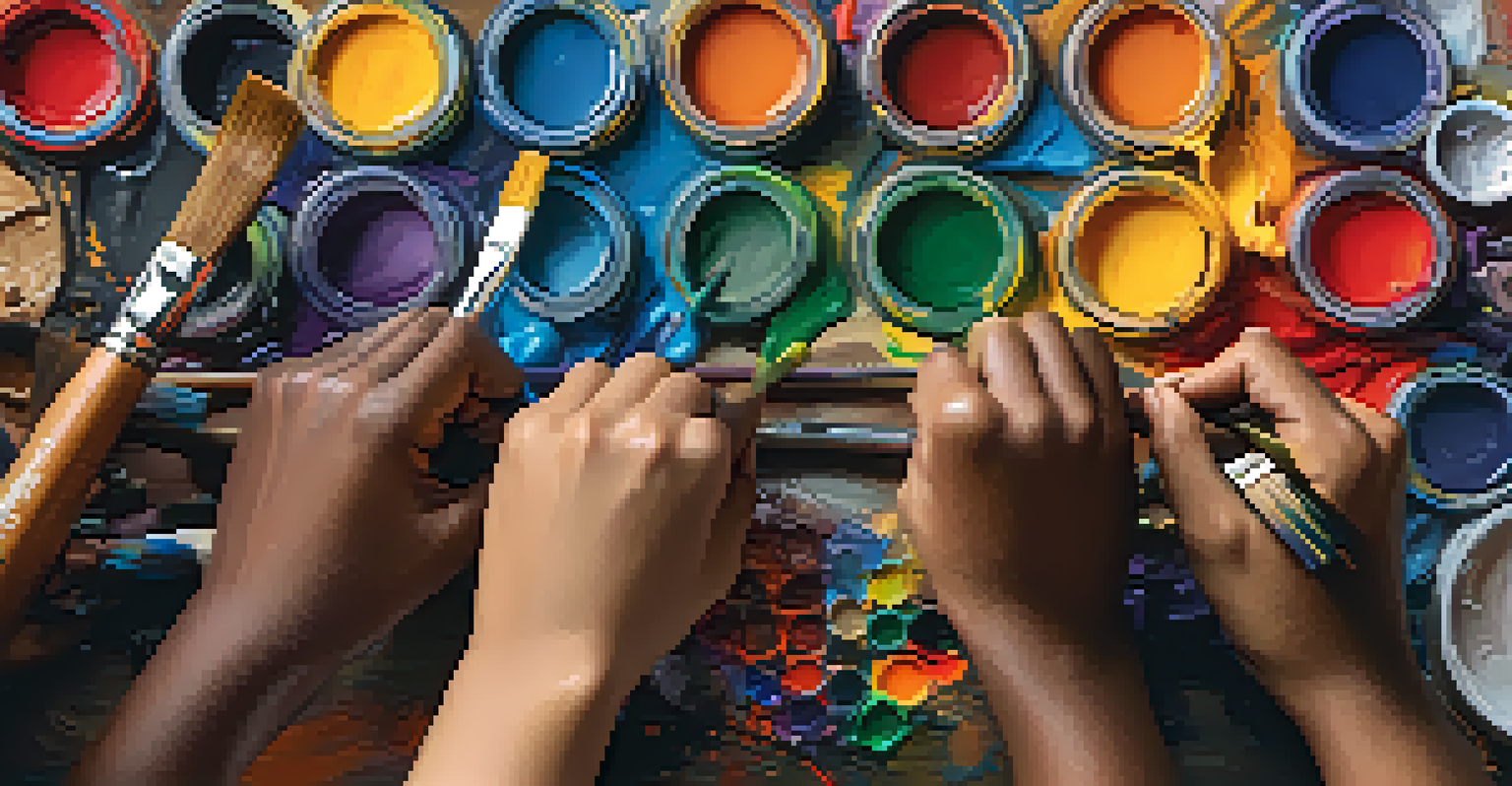Art Collectives: Collaborations for Social Change

Understanding Art Collectives and Their Purpose
Art collectives are groups of artists who come together to create, support, and promote their work. They often share a common vision or goal, which can range from artistic expression to social activism. By pooling their resources and talents, these collectives can amplify their impact in ways that individual artists might struggle to achieve alone.
Art is not a mirror held up to reality but a hammer with which to shape it.
The essence of an art collective lies in collaboration. This teamwork fosters creativity, allowing artists to explore new ideas and perspectives. For instance, when artists from different backgrounds collaborate, they can create works that speak to a broader audience, addressing diverse issues and experiences.
Moreover, art collectives often engage with their communities. By involving local residents in their projects, they ensure that their art resonates with the people it’s meant to serve. This connection can lead to meaningful dialogue and inspire collective action, showcasing the transformative power of art.
The Role of Collaboration in Art Collectives
Collaboration is the lifeblood of art collectives; it allows for the sharing of ideas, techniques, and expertise. When artists collaborate, they bring unique perspectives that can enrich the creative process. This synergy often leads to innovative projects that might not have been possible for an individual artist working alone.

Take, for example, the collective Fuerza, which focuses on empowering marginalized communities through art. By collaborating with activists and community leaders, they create impactful works that challenge social injustices. This collaborative effort not only enhances the artwork but also strengthens community ties.
Art Collectives Drive Social Change
Art collectives harness creativity and collaboration to address societal issues and inspire community action.
Additionally, collaboration fosters a sense of belonging and support among artists. It creates a network where members can share challenges, successes, and resources. This camaraderie can be incredibly motivating, helping artists push boundaries and pursue ambitious projects that seek to effect social change.
Art Collectives as Agents of Social Change
Art collectives often serve as catalysts for social change by addressing pressing societal issues through their work. They have the power to raise awareness about topics such as climate change, inequality, and systemic injustice. By using their art as a platform, they can spark conversations that challenge the status quo.
The role of the artist is to make the revolution irresistible.
An excellent example is the Guerrilla Girls, a group of feminist artists who use humor and bold visuals to confront sexism and racism in the art world. Their provocative campaigns have not only raised awareness but have also encouraged action against inequality in the industry. Such collectives demonstrate how art can be a powerful tool for advocacy.
Moreover, art collectives often collaborate with other organizations, including non-profits and community groups, to expand their reach and impact. These partnerships can amplify their messages and mobilize resources, making their efforts even more effective. In this way, art becomes a vehicle for community empowerment and social progress.
Case Studies: Successful Art Collectives Leading Change
Examining successful art collectives can provide insight into effective strategies for driving social change. For instance, the collective Artivism merges activism with artistic expression, creating powerful installations that engage the public on issues like immigration and environmental justice. Their projects often invite community participation, fostering a sense of ownership and involvement.
Another notable example is the Black Artists and Designers Guild, which focuses on promoting Black creatives in the design field. Through collaboration, they create opportunities for visibility and recognition, addressing systemic barriers within the industry. Their work highlights the importance of representation and inclusivity in the arts.
Collaboration Fuels Creativity
Collaboration among diverse artists enriches the creative process, leading to innovative projects that amplify their impact.
These case studies illustrate that the impact of art collectives extends beyond the art itself; it creates a ripple effect that can influence societal attitudes and policies. By examining their successes, we can learn valuable lessons about the power of collaboration and the potential of art to inspire meaningful change.
Challenges Faced by Art Collectives
Despite their many benefits, art collectives face unique challenges that can hinder their effectiveness. Funding is often a significant issue, as many collectives rely on grants and donations to support their projects. This financial uncertainty can limit their ability to execute ambitious initiatives and sustain their operations.
Additionally, maintaining a cohesive vision can be difficult when diverse artists come together. Conflicting ideas or goals may arise, which can lead to tension within the group. Effective communication and strong leadership are essential to navigate these challenges and keep the collective focused on its mission.
Finally, art collectives may struggle with visibility in an art market that often prioritizes individual artists. Building a recognizable brand and audience can be challenging, especially when competing against well-established names. However, through strategic marketing and community engagement, many collectives successfully carve out their niche in the art world.
The Future of Art Collectives in Social Change
As society continues to evolve, so too will the role of art collectives in driving social change. The rise of digital platforms offers new opportunities for artists to collaborate and share their work globally. This increased connectivity can lead to powerful movements that transcend geographic boundaries and amplify their impact.
Moreover, issues like climate change and social justice are becoming more urgent, leading to a greater demand for artistic activism. Art collectives have the potential to address these critical topics creatively, inspiring action and encouraging dialogue within communities. Their unique ability to blend art and activism positions them well for the challenges ahead.
Overcoming Challenges Together
Despite facing funding and visibility challenges, art collectives can thrive through effective communication and community support.
In the coming years, we can anticipate more art collectives emerging, each with its unique focus and approach. These groups will likely continue to push boundaries, challenge norms, and elevate voices that have been historically marginalized. The future of art collectives is bright, promising a vibrant landscape for creativity and social change.
Getting Involved with Art Collectives
If you're inspired by the work of art collectives, you may be wondering how to get involved. Many collectives welcome new members, offering opportunities for artists and non-artists alike to contribute their skills and passions. Whether you're an artist, activist, or simply someone who cares about social issues, your input can be valuable.
Attending events, workshops, or exhibitions hosted by art collectives is a great way to learn more and meet like-minded individuals. These gatherings often foster community and collaboration, allowing participants to share ideas and experiences. Engaging with these groups can deepen your understanding of the issues they address and the art they produce.

Additionally, supporting art collectives through donations or volunteering can help sustain their important work. Many collectives rely on community support to fund their projects and initiatives. By contributing your time or resources, you can play a part in the ongoing efforts to harness art for social change.